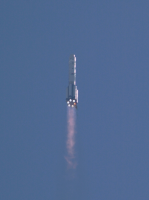








Spaceflight is ballistic flight into or through outer space. Spaceflight can occur with spacecraft with or without humans on board. Examples of human spaceflight include the Russian Soyuz program, the U.S. Space shuttle program, as well as the ongoing International Space Station. Examples of unmanned spaceflight include space probes that leave Earth orbit, as well as satellites in orbit around Earth, such as communications satellites. These operate either by telerobotic control or are fully autonomous.
The realistic proposal of space travel goes back to Konstantin Tsiolkovsky.
Spaceflight became an engineering possibility with the work of Robert H. Goddard's publication in 1919 of his paper 'A Method of Reaching Extreme Altitudes'; where his application of the de Laval nozzle to liquid fuel rockets improved efficiency enough for interplanetary travel to become possible. He also proved in the laboratory that rockets would work in the vacuum of space; not all scientists of that day believed they would. This paper was highly influential on Hermann Oberth and Wernher Von Braun, later key players in spaceflight.
The first rocket to reach space, an altitude of 189 km, was the German V-2 rocket, on a test flight in June 1944.On 4 October 1957, the Soviet Union launched Sputnik 1, which became the first artificial satellite to orbit the Earth. The first human spaceflight was Vostok 1 on April 12, 1961, aboard which Soviet cosmonaut Yuri Gagarin made one orbit around the Earth. The lead architects behind the Soviet space program's Vostok 1 mission were the rocket scientists Sergey Korolyov and Kerim Kerimov.
Rockets are the only means currently capable of reaching orbit. Other non-rocket spacelaunch technologies have yet to be built, or remain short of orbital speeds.